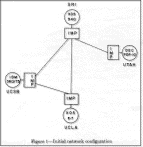 The precursor to the Internet, ARPANET was a large wide-area network created by the United States Defense Advanced Research Projects Agency. Established in 1969, ARPANET served as a testbed for new networking technologies, linking many universities and research centers. The first two nodes that formed the ARPANET were UCLA and the Stanford Research Institute, followed shortly thereafter by the University of Utah.
The precursor to the Internet, ARPANET was a large wide-area network created by the United States Defense Advanced Research Projects Agency. Established in 1969, ARPANET served as a testbed for new networking technologies, linking many universities and research centers. The first two nodes that formed the ARPANET were UCLA and the Stanford Research Institute, followed shortly thereafter by the University of Utah.
Larry Roberts and Bob Taylor are primarily responsible for the project when Taylor, then head of computing programs at ARPA, starts the ball rolling for the creation of a national computer network. He shared predecessor J.C.R. Licklider’s view, and moves forward with a plan for creating a network of electronic links among the computers at various research centers.
He hires Larry Roberts to head the project and three years later ARPANet is born. The network would rely on Robert’s theory on machines called Interface Message Processor (IMPs), which would connect, route messages, scan for errors and confirm arrival. After hundreds of proposals, the contract to build them goes to Bolt, Beranek and Newman (BBN). They work around the clock to deliver the first one by the Labor Day 1969 deadline. Requests for assistance goes out to the “Intergalactic Network”, and the response is overwhelming as mostly graduate students prepare their host computers for IMPs.
Linked by dedicated phone lines, all of the first four IMPs are in place on schedule and allow users to log on to remote computers and run their programs. This four node preliminary trial is successful, and by spring of 1971 nineteen other sites across the country have joined. The next year the network makes it’s public appearance and the idea of a more expansive network takes root. Others are involved in ARPAnet’s design and completion, and they develop new protocols, write software, connect wires, and unknowingly start the network revolution.
